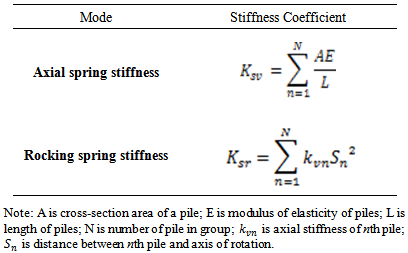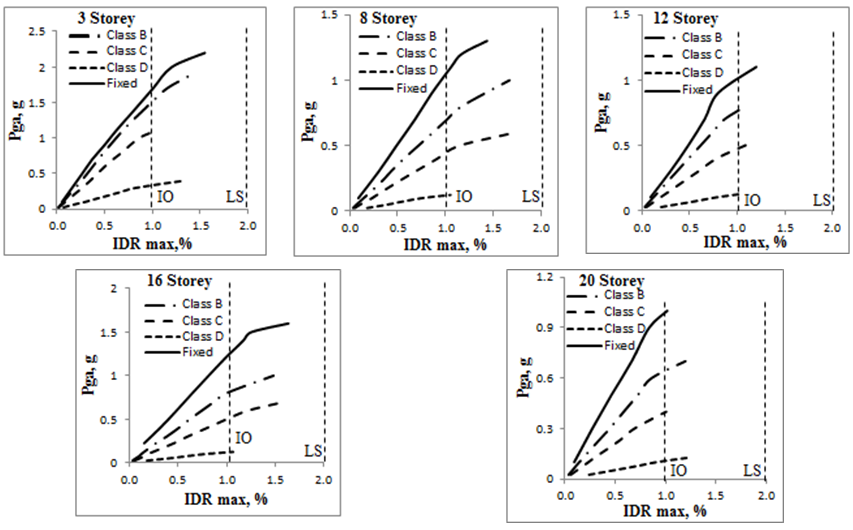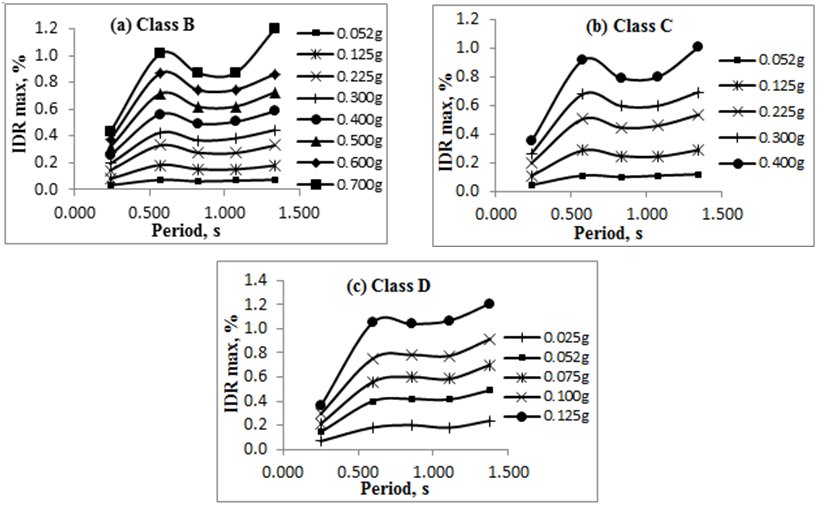Chee-Ghuan Tan1, Taksiah A. Majid2, Kamar Shah Arriffin2, Norazura Mohamad Bunnori1
1School of Civil Engineering, Universiti Sains Malaysia, Penang, Malaysia
2School of Material and Mineral Resources, Universiti Sains Malaysia, Penang, Malaysia
Correspondence to: Chee-Ghuan Tan, School of Civil Engineering, Universiti Sains Malaysia, Penang, Malaysia.
| Email: |  |
Copyright © 2014 Scientific & Academic Publishing. All Rights Reserved.
Abstract
Malaysia has been long term subjected to far field from neighboring country and local earthquake although it is not located in the active fault region. Local soil condition or site classification may play a major role in the soil dynamic characteristic correspond to the tremors. This study is to evaluate the effect of site classification on seismic response to the non-seismic design existing RC buildings in Penang. Five types of moment resistance RC building with 3, 8, 12, 16 and 20 storey are evaluated by using Incremental Dynamic Analysis (IDA). IDA result show that the non-seismic designed RC frames behaved low ductility and collapse at relatively lower IDRmax which between the performance level of Immediate Occupancy, IO (1%) and Life Safety, LS (2%). 20 storey buildings give the highest IDRmax followed by 8 storey buildings for every type of site classification. This phenomenon is more obvious in harder soil (Class B) and the effect reduces in softer soil condition by observing the slope reduction of the IDRmax vs T1 curves.
Keywords:
Site classification, Incremental dynamic analysis, Maximum interstorey drift ratio
Cite this paper: Chee-Ghuan Tan, Taksiah A. Majid, Kamar Shah Arriffin, Norazura Mohamad Bunnori, The Effect of Site Classification on Incremental Dynamic Analysis for RC Buildings without Seismic Provision in Penang, Journal of Civil Engineering Research, Vol. 4 No. 3A, 2014, pp. 154-158. doi: 10.5923/c.jce.201402.27.
1. Introduction
Dynamic soil properties provide important information on the dynamic response of the soil structure needed for the dynamic structural analysis of superstructures. Local site classification always plays a major role in the seismic soil amplification of a site, a critical factor affecting the level of ground shaking [1]. Although Malaysia is not located close to the seismic prone area with active fault, buildings erected on soft soils often exposed to the far-field earthquakes generated from along Sumatran fault and subduction zones, particularly in areas on the west coast of Peninsular Malaysia, such as in Penang, Johor Bharu, and Kuala Lumpur [2, 3]. In the past 30 years, over 40 earthquakes originating from the Sumatra fault and subduction zone have been recorded in Penang, two of which are among the greatest earthquakes in the world [4]. Table 1 summarises the most recent significant earthquake events (MMI ≥ IV) that have been felt in Penang and have caused panic to the local citizens. Malaysian Meteorological Department has recorded that a series of local earthquakes (intra-plate fault) in Peninsular Malaysia and Sabah in the past 5 years as shown in Table 2.Table 1. Recent earthquakes (MMI ≥ IV) from the Sumatran fault and subduction zone experienced by Penang (Malaysian Meteorological Department)
 |
| |
|
Table 2. Recent local earthquakes in Malaysia (Mb ≥ 3.8) (Malaysian Meteorological Department)
 |
| |
|
Malaysia has been long term subjected to far field and local earthquake, this have been raised questions on the structural stability and the integrity of the existing building which is not designed seismically in Malaysia in tackling of the far field earthquakes effect from Sumatra and local earthquakes. The vulnerability of these non-seismic BS designed buildings either a distance earthquake originated from at Sumatra or local source may also increase due the low performance of its joint ductility. This study is to evaluate the effect of site classification on seismic response to the existing reinforced concrete (RC) buildings in Penang.
2. Consideration of Site Classification in Structural Analysis
2.1. Models
Five types of RC building with storey height of 3, 8, 12, 16 and 20-storey were selected for the analysis in this study. The selections of these buildings are intended to consider the low, medium and the high-rise buildings in order to cover the wider range of building’s fundamental period from 0.2 s to 1.4 s in the analysis. The selected frame which has 2 bays framing and 3.0 m storey height was structurally designed by using EsteemPlus software. British Standard 8110 [5] was adopted as the design code since the aim of the study is to evaluate the seismic resistance for the non-seismic designed RC buildings in Malaysia. The design parameters for the RC building are tabulated in Table 3.Table 3. Design parameter of RC frames
 |
| |
|
2.2. Soil-Structure Presentation
Pile foundations are considered since the buildings in this study consist of low, medium and high-rise buildings. According to Fema356 [6], the footing uncouple spring model shall be represented by a various spring stiffness in difference axes. The pile cap spring stiffness was expressed in the horizontal, vertical and rotational springs since the two dimensional frame were considered. The embedment of the pile caps are represented by the spring stiffness which is multiplied by the embedment factor according as shown in Table 4. The vertical axial spring stiffness, ksv and rotational spring stiffness, ksr of the pile group are shown in Table 5.Table 4. Expression for spring stiffness and their corresponding embedment factor for pile cap [6]
 |
| |
|
Table 5. Expression for spring stiffness of pile group [6]
 |
| |
|
3. Incremental Dynamic Analysis
Incremental dynamic analysis (IDA) involves implementing a series of nonlinear time history analyses to a structure for multiple ground motion records by scaling every record to several levels of intensity to discover the full range of the structure’s behaviour from elastic to yielding, nonlinear inelastic and eventually leading to global instability [7]. To comply with the minimum requirement of the codes, seven ground motions were used for the nonlinear time history analysis as tabulated in Table 6. Tan el al. [4] had concluded that the site classification of Penang consists of Soil Type B (Vs = 360 - 800 m/s), C (Vs = 180 - 360 m/s) and D (Vs < 180 m/s) as defined in Eurocode 8 [8], hence only ground motion records with these three soil types were selected. Moreover, far field ground motion records were selected due to the studied area only subjected to far field earthquakes. IDA carried out have covered (i) five types of fundamental period of moment resistance frame (MRF); (ii) four types of foundations (three flexible and one fixed); (iii) seven ground motions; (iv) fourteen types peak ground accelerations by using SAP2000. Total numbers of 1960 nonlinear time history analyses have been carried out in the IDA.
3.1. The Effect of the Site Classification on IDA
Figure 1 shows the IDA curves for 3, 8, 12, 16 and 20 storey buildings. Noted that the parameter of peak ground acceleration (PGA) was used as the intensity of seismic action in the IDA instead of the first mode spectral acceleration, Sa(T1) because of PGA is more familiar and applicable to the academic and industry sectors in Malaysia. The results indicated that the increase of the building storey height and lower soil hardness had reduced the stiffness of the IDA curves. IDA curves show that buildings in Class D site have comparable much higher maximum interstorey drift ratios, IDRmax for the same PGA than other sites. | Figure 1. IDA curves for 3, 8, 12, 16 and 20 storey buildings |
The typical performance levels and the associated damages state according to FEMA indicated that the concrete frame is expected to collapse at 3% to 4 % of the drift. However, all IDA curves found the non-seismic designed RC frames behaved low ductility and collapse at relatively lower IDRmax which between the performance level of Immediate Occupancy, IO (1%) and Life Safety, LS (2%). The discrepancy of this result can be explained by the finding of the Ghobarah [9]. He concluded that the drift limits in current available codes are found not suitable for the structures which designed without seismic detailing as in this study. The MRF of this structure behave in a non-ductile manner and often suffer in brittle failure modes due to poor confinement of lap splices, lack of shear reinforcement in the beam-column joint and inadequate embedment. More importantly, he had established the drift ratio limits associated with damage levels for various types of structures as shown in Table 7. His result concluded that the collapse of non-ductile MRF structures would happen at more than 1.0% IDR which fully support the finding of the current study. | Table 6. Selected far-field ground motion records for nonlinear time history analysis (PEER) |
Table 7. IDRmax associated with various damage level [%] [9]
 |
| |
|
3.2. IDRmax with Respective to Storey Height RC Buildings
IDRmax versus building fundamental period (T1) with respect to various site classification and PGA are plotted as shown in Figure 2. The T1 for 3, 8, 12, 16 and 20 storeys are 0.236 s, 0.567 s, 0.824 s, 1.071 s and 1.333 s, respectively. It noted that the maximum PGA plotted in these graphs are up to 0.7 g, 0.4 g and 0.125 g for Class B, Class C and Class D, respectively. The results show that the 20 storey buildings give the highest IDRmax followed by 8 storey buildings for every type of site classification. This phenomenon is more clearly observed in harder soil (Class B) and the effect reduces as the soil become soft by observing the slope reduction of the curves. | Figure 2. The IDRmax plot with respect to T1 of the buildings for (a) Class B, (b) Class C and (c) Class D |
4. Conclusions
Total numbers of 1960 nonlinear time history analyses have been carried out to produce the IDA curves for 3, 8, 12, 16 and 20 storey non-seismic designed RC buildings. IDA curves found the non-seismic designed RC frames behaved low ductility and collapse at relatively lower IDRmax which between the performance level of Immediate Occupancy (1%) and Life Safety, LS (2%). This may due to the non-seismic resistance RC structure behave in a non-ductile manner and often suffer in brittle failure modes due to poor confinement of lap splices, lack of shear reinforcement in the beam-column joint and inadequate embedment. IDA results shows that the 20 storey buildings (T1 = 1.33 s) give the highest IDRmax followed by 8 storey buildings (T1 = 0.57 s) for every type of site classification.
ACKNOWLEDGEMENTS
This study was sponsored by the Postgraduate Research Grant Scheme provided by Universiti Sains Malaysia. The authors would like to extend their gratitude to the Ministry of Education of Malaysia for the permission to collect MASW data from primary and secondary schools in the study area.
References
| [1] | R.U. Maheswari, A. Boominathan, and G.R. Dodagoudar, Seismic site classification and site period mapping of Chennai City using geophysical and geotechnical data. J. Appl. Geophys., 2010. 72(3): pp. 152-168. DOI: 10.1016/j.jappgeo.2010.08.002. |
| [2] | A. Adnan, et al., Seismic hazard assessment for Peninsular Malaysia using Gumbel Distribution Method. Jurnal Teknologi, 2005. 42 (B): pp. 57-73. |
| [3] | H. Husen, et al. Development of design response spectra based on various attenuation relationships at specific location. International Conference on Construction and Building Technology. Kuala Lumpur, Malaysia 2008 pp. 511-518. |
| [4] | C.G. Tan, et al., Seismic microzonation for Penang using geospatial contour mapping. Natural Hazards, 2014.DOI: 10.1007/s11069-014-1093-8. |
| [5] | British Standard 8110, Part 1. Structural use of concrete: Code of Practice for Design and Construction, 1997: Milton Keynes. |
| [6] | FEMA356, Prestandard and Commentary for the Seismic Rehabilitation of Buildings, in Federal Emergency Management Agency 2000: Washington, D. C. |
| [7] | D. Vamvatsikos and C.A. Cornell, Direct estimation of seismic demand and capacity of multidegree-of-freedom systems through incremental dynamic analysis of single degree of freedom approximation. Journal of Structural Engineering, 2005. 131(4): pp. 589-599. |
| [8] | CEN., Eurocode 8: Design of structures for earthquake resistance. Part 1: General rules, seismic actions and rules for buildings, 2004, European Committee for Standardization: Brussels. |
| [9] | A. Ghobarah. On Drift Limits Associated with Different Damage Levels. International Workshop on Performance-Based Seismic Design. McMaster University 2004. |




 Abstract
Abstract Reference
Reference Full-Text PDF
Full-Text PDF Full-text HTML
Full-text HTML




